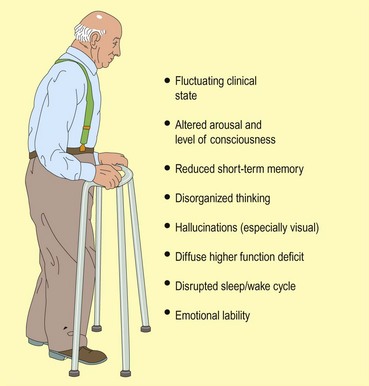Confusion and delirium
Introduction
The manifestation of any confusional state or delirium depends on the premorbid state of the patient. A patient with a pre-existing higher function deficit will be more prone to florid delirium than someone with normal higher function. Common causes of confusion include metabolic illness, drug toxicity, systemic infections and CNS pathology such as encephalitis or subdural haematoma. Difficult to diagnose but treatable causes are non-convulsive status epilepticus (uncommon) and autoimmune ‘limbic’ encephalitis (rare) which is often a paraneoplastic condition (p. 96).
Clinical features
Delirium comes on within hours to a few weeks (Fig. 1). There is a prominent fluctuation in symptomatology. Patients are distractible and disorganized in thinking. They are slow to respond and may find it difficult to answer questions without going off at a tangent. Their speech may be slurred. They may report hallucinations which are often visual, florid and menacing. Their sleep pattern becomes disrupted with sleeping in the day and waking at night. Most patients become physically slowed. They usually have a prominent loss of short-term memory, reflecting their poor attention. Patients become emotionally labile, being tearful or frightened, or become angry and agitated relatively easily. Some patients can become hyperactive and very agitated.








